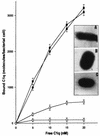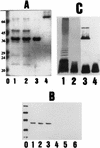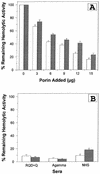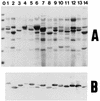Activation of the complement classical pathway (C1q binding) by mesophilic Aeromonas hydrophila outer membrane protein
- PMID: 9673268
- PMCID: PMC108428
- DOI: 10.1128/IAI.66.8.3825-3831.1998
Activation of the complement classical pathway (C1q binding) by mesophilic Aeromonas hydrophila outer membrane protein
Abstract
The mechanism of killing of Aeromonas hydrophila serum-sensitive strains in nonimmune serum by the complement classical pathway has been studied. The bacterial cell surface component that binds C1q more efficiently was identified as a major outer membrane protein of 39 kDa, presumably the porin II described by D. Jeanteur, N. Gletsu, F. Pattus, and J. T. Buckley (Mol. Microbiol. 6:3355-3363, 1992), of these microorganisms. We have demonstrated that the purified form of porin II binds C1q and activates the classical pathway in an antibody-independent manner, with the subsequent consumption of C4 and reduction of the serum total hemolytic activity. Activation of the classical pathway has been observed in human nonimmune serum and agammaglobulinemic serum (both depleted of factor D). Binding of C1q to other components of the bacterial outer membrane, in particular to rough lipopolysaccharide, could not be demonstrated. Activation of the classical pathway by this lipopolysaccharide was also much less efficient than activation by the outer membrane protein. The strains possessing O-antigen lipopolysaccharide bind less C1q than the serum-sensitive strains, because the outer membrane protein is less accessible, and are resistant to complement-mediated killing. Finally, a similar or identical outer membrane protein (presumably porin II) that binds C1q was shown to be present in strains from the most common mesophilic Aeromonas O serogroups.
Figures







Similar articles
-
C1q binding and activation of the complement classical pathway by Klebsiella pneumoniae outer membrane proteins.Infect Immun. 1993 Mar;61(3):852-60. doi: 10.1128/iai.61.3.852-860.1993. Infect Immun. 1993. PMID: 8432605 Free PMC article.
-
A C1q-binding 40 kDa porin from Aeromonas salmonicida: cloning, sequencing, role in serum susceptibility and fish immunoprotection.Microb Pathog. 2005 May-Jun;38(5-6):227-37. doi: 10.1016/j.micpath.2005.02.006. Microb Pathog. 2005. PMID: 15885977
-
Antibody-independent binding of complement component C1q by Legionella pneumophila.Infect Immun. 1995 Dec;63(12):4939-43. doi: 10.1128/iai.63.12.4939-4943.1995. Infect Immun. 1995. PMID: 7591161 Free PMC article.
-
Interaction of fluid phase C1/C1q and macrophage membrane-associated C1q with gram-negative bacteria.Behring Inst Mitt. 1989 Jul;(84):236-54. Behring Inst Mitt. 1989. PMID: 2552981 Review.
-
[Immune and nonimmune complement activation].Rev Clin Esp. 1996 Mar;196 Spec No:3-6. Rev Clin Esp. 1996. PMID: 9206805 Review. Spanish. No abstract available.
Cited by
-
The cytotoxic enterotoxin of Aeromonas hydrophila induces proinflammatory cytokine production and activates arachidonic acid metabolism in macrophages.Infect Immun. 2000 May;68(5):2808-18. doi: 10.1128/IAI.68.5.2808-2818.2000. Infect Immun. 2000. PMID: 10768977 Free PMC article.
-
Activation of the classical complement pathway by Bacillus anthracis is the primary mechanism for spore phagocytosis and involves the spore surface protein BclA.J Immunol. 2012 May 1;188(9):4421-31. doi: 10.4049/jimmunol.1102092. Epub 2012 Mar 21. J Immunol. 2012. PMID: 22442442 Free PMC article.
-
Pathogenic Aeromonas hydrophila serogroup O:14 and O:81 strains with an S layer.Appl Environ Microbiol. 2004 Oct;70(10):5898-904. doi: 10.1128/AEM.70.10.5898-5904.2004. Appl Environ Microbiol. 2004. PMID: 15466530 Free PMC article.
-
Outer membrane proteins of pathogenic spirochetes.FEMS Microbiol Rev. 2004 Jun;28(3):291-318. doi: 10.1016/j.femsre.2003.10.004. FEMS Microbiol Rev. 2004. PMID: 15449605 Free PMC article. Review.
-
Cloning, sequencing, and role in serum susceptibility of porin II from mesophilic Aeromonas hydrophila.Infect Immun. 2000 Apr;68(4):1849-54. doi: 10.1128/IAI.68.4.1849-1854.2000. Infect Immun. 2000. PMID: 10722573 Free PMC article.
References
-
- Alcolea J M, Antón C, Marqués G, Sánchez-Corral P, Vivanco F. Formation of covalent complexes between the fourth component of human complement and IgG immune aggregates. Complement. 1987;4:21–32. - PubMed
Publication types
MeSH terms
Substances
LinkOut - more resources
Full Text Sources
Miscellaneous

